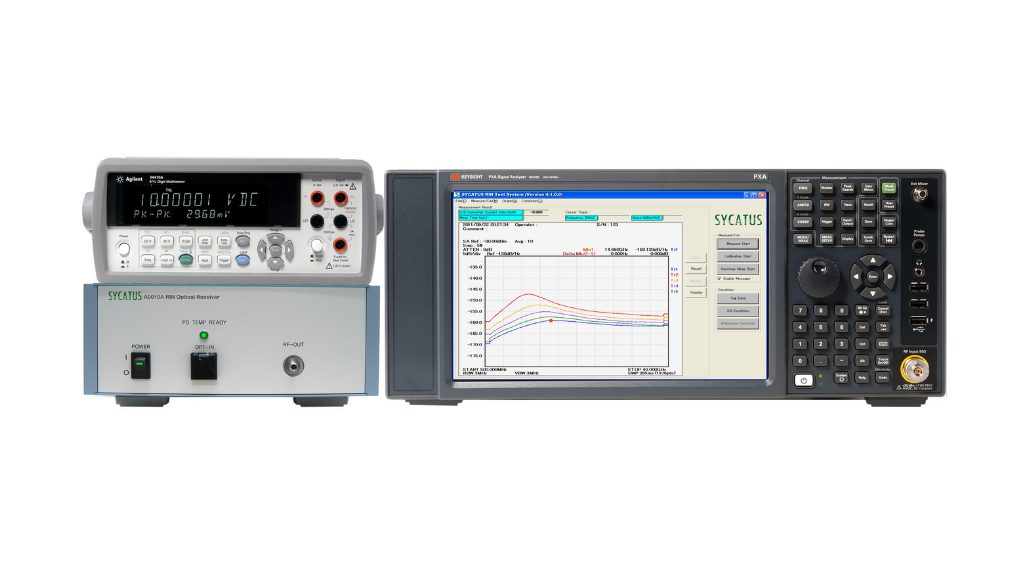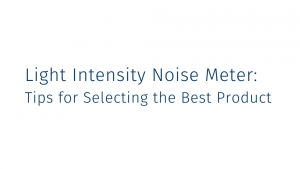Optical noise measurement systems are an essential tool for improving the performance of optical communications and ensuring efficient data transmission.
Some researchers and engineers may consider building their own optical noise measurement systems.
What are the advantages of building your own optical noise measurement system? What are the risks and difficulties involved in putting a home-built measurement system to practical use? What measures are necessary to avoid them?
This article focuses on these questions and discusses the feasibility of a home-built optical noise measurement system.
What is an optical noise measurement system?
Basic Knowledge of Optical Noise
Optical noise in optical communications refers to unwanted optical signals mixed with transmitted optical signals. These signals are generated in various elements such as optical transceivers, optical fibers, and optical amplifiers, and the more optical noise there is, the lower the communication quality.
Specific sources of optical noise include fluctuations in laser light, scattering in fibers, electronic circuits in optical transceivers, and spontaneous emissions from optical amplifiers. Optical noise directly affects transmission capacity, transmission distance, and signal quality, and can cause communication errors and limit transmission speed. Therefore, understanding and countermeasures against optical noise are essential to improve the performance of optical communication systems.
Optical Noise Measurement Systems and Their Applications
Optical noise measurement systems for communications are devices that precisely measure noise generated by lasers, optical transceivers, and optical fibers to achieve optimal communication quality. The objective is to measure various types of optical noise, such as intensity noise, frequency noise, and phase noise of laser light.
By detecting noise in transmitted laser light and analyzing its characteristics, the optical noise measurement system identifies the type and source of noise and provides guidelines for improving communication quality.
Optical noise measurement systems are applied in a variety of situations, including new product development, standard testing in manufacturing, and quality assurance.
As optical communication speeds and capacities have increased in recent years, the impact of optical noise on communication has been growing. Therefore, the use of optical noise measurement systems is essential for improving communication quality.
Optical noise measurement systems are also used in the development and manufacturing process of laser-based sensing devices. Since optical noise affects the accuracy of sensing in these devices, it is important to promptly identify the cause of optical noise and take countermeasures.
Is it possible to create my own optical noise measurement system?
We will now pursue the theme of this issue, "Is it possible to create my own optical noise measurement system?".
The answer to this question is:
Yes, it is possible. However, it requires a high level of knowledge and the correct method.
Developing a system with sufficient requirements for optical noise measurement requires expert knowledge of electronics, optical physics, and signal processing.
It also requires an understanding of the structure of the optical noise measurement system and its proper design.
For example, a relative intensity noise (RIN) measurement system consists of a combination of a photodetector, amplifier, and spectrum analyzer.
By combining these instruments, it is possible to construct a relative intensity noise (RIN) measurement system.
However, it requires a lot of time and effort to put it into practical use, and without specialized knowledge, it is difficult to make accurate measurements.
In the next section, we will explore in detail the advantages and disadvantages of trying to build your own system, as well as countermeasures to the challenges that arise when building your own system.
What are the advantages of making your own system?
Advantage 1: Costs can be reduced
If inexpensive equipment is selected and measurements are performed manually without software, costs can be significantly reduced compared to commercially available products.
Advantage 2: Customization is possible
By changing the selection of equipment, it is possible to accommodate special wavelengths and bandwidths that are not supported by commercially available measurement systems. The system can also be customized to specialize only in specific measurement conditions.
Advantage 3: Better understanding of the system
By creating your own system, you can deepen your understanding of the details of the system. Because you made it yourself, you understand what components are used and what processes are used to measure optical noise, so you will be able to deal with system problems on your own when they arise.
However, self-building comes with its own risks. In the next section, we will look at the disadvantages of creating your own system and what you can do about them.
What are the disadvantages of making your own system?
Disadvantage 1: Correct measurement results cannot be obtained
It is difficult to obtain correct measurement results with a home-built system. If the measurement accuracy of the system is low, it will not be able to accurately measure optical noise, resulting in erroneous results.
If the accuracy of optical noise detection is not sufficient, various factors should be pursued.
The main causes could be the difference between the design and the actual system or the performance of the components used. Designing and manufacturing a system is complex and requires selecting the right equipment and assembling it correctly. Testing is also essential to ensure that the system is functioning properly.
These tasks are challenging because they require a high degree of expertise and experience.
【For example, a relative intensity noise (RIN) measurement system must meet the following requirements in order to obtain correct measurement results】
- Application of an appropriate relative intensity noise (RIN) evaluation scheme: The physical meaning of laser intensity noise, shot noise, and equipment thermal noise must be understood, and the measurement system must be correctly designed to accurately identify and separate them.
- Selecting the right equipment for relative intensity noise (RIN) measurements: Because relative intensity noise (RIN) evaluates very low-level signals over a wide bandwidth of up to 50 GHz, the equipment in the measurement system must be properly selected so that the laser intensity noise is not buried by the thermal noise of the equipment in the measurement system throughout the entire measurement range. The measurement system equipment must be properly selected so that the laser intensity noise is not buried by the thermal noise of the measurement system equipment throughout the measurement.
- Calibration of the entire relative intensity noise (RIN) measurement system: There are individual differences in the characteristics of the instruments that make up the measurement system. The accumulation of these individual differences can result in a measurement system as a whole having a large error in the expected characteristics. Since the error also depends on the interaction between the instruments, it is not possible to eliminate the error by simply understanding the characteristics of the individual instruments. To ensure that such errors are compensated for, the entire RIN measurement system must be calibrated.
Disadvantage 2: Inability to support the required functions
A self-made optical noise measurement system may not have all the necessary functions.
For example, it may be difficult to realize functions to extract specific parameters from optical noise or to capture transient fluctuations in noise.
On the other hand, commercially available products from companies incorporate useful features that have been optimized for optical noise measurements through years of research and development.
It is difficult to implement such features in a home-made system, and significant time and money is spent to make it happen.
【Relative Intensity Noise (RIN) measurement systems must be able to evaluate in multiple metrics, as follows】
- Noise power density spectrum: RIN must be evaluated on the frequency axis as a noise power density spectrum. Especially for DFB lasers, the relaxation oscillation frequency, which is the peak frequency of RIN, is an important parameter. The relaxation frequency is closely related to the modulation bandwidth of DFB lasers and is sometimes used for selection in manufacturing.
- RIN × OMA: Based on IEEE802.3, the leading standard for optical transceivers, it is required to be able to calculate RIN × OMA, which is adopted by most optical transceiver standards specified in IEEE802.3; RIN × OMA is also used in the IEEE802.3 standard.
- RIN average: The software is required to calculate the average value of RIN in any 3 dB bandwidth; a filter with Bessel-Thomson characteristics in a given bandwidth must be applied to the RIN spectrum.
Disadvantage 3: Software creation is time-consuming
Designing and operating one's own optical noise measurement system requires specialized software.
This software is designed to collect, analyze, and display data, and its development takes time and effort. In addition, developing and maintaining software to facilitate data analysis and interpretation requires specialized knowledge and skills.
In addition, homegrown systems must be continually updated and improved according to the latest technological trends and measurement methods.
Moreover, if a software bug or problem arises, it must be handled entirely at one's own risk, as no support exists to correct it. This can consume significant time and resources.
In addition, to efficiently proceed with RIN measurements, the software must be compatible with automation.
【Software creation requires significant effort in the following areas】
- Software design: The RIN measurement method must be broken down into specific procedures, and then the software must be designed to accurately reflect these procedures.
- Control of multiple measurement devices: It is required to set up the interface of each device that makes up the RIN measurement system, select the control commands for the devices corresponding to the procedure, and incorporate these commands into the software by making them into functions.
- Compatibility of stand-alone and remote control: In addition to performing RIN measurement as a stand-alone system from the software GUI, it is also necessary to system up with other instruments and remotely control the RIN measurement system from another software. In this case, the software must be written in such a way that the stand-alone and remotely controlled RIN measurement software can work together seamlessly.
Conclusion: The Possibility and Value of Building Your Own Optical Noise Measurement System
In this article, we discussed the possibility of creating one's own optical noise measurement system.
Measuring optical noise requires a high level of specialized knowledge and skills.
For engineers and researchers with specialized knowledge, a self-made path may be an option, but self-made optical noise measurement systems are extremely challenging, and to obtain accurate measurement results, it is recommended to use a measurement device that meets the necessary requirements.
To avoid potential problems that may arise from building your own system, we recommend that you purchase a product from a reliable manufacturer.
SYCATUS Relative Intensity Noise Analyzer "A0010A RIN Measurement System"
The A0010A RIN measurement system from SYCATUS uses a high-sensitivity, low-noise optical receiver optimally designed for relative intensity noise (RIN) measurements and a high-performance X-Series signal analyzer from Keysight Technologies, Inc, The world's widest measurement bandwidth of 50 GHz is used to evaluate the spectrum of relative intensity noise.

SYCATUS' proprietary system-wide calibration technology provides superior measurement accuracy and repeatability.
We also offer easy-to-operate GUI software and automation software that can be integrated into many software development environments.
We hope you will utilize our A0010A measurement system for your laser development, manufacturing, and evaluation.
Feel free to contact us.
As a pioneer in measurement in the field of optical communications and optical sensing, SYCATUS has been providing integrated hardware and software systems for measurement for over 20 years.
We will continue to provide innovative optical measurement technologies developed on the basis of expertise, uniqueness, and accuracy to the world.
We also provide expert advice on a wide range of optical measurement questions and concerns regarding the installation of system equipment.
Our experts are available to help you solve your optical measurement problems.


